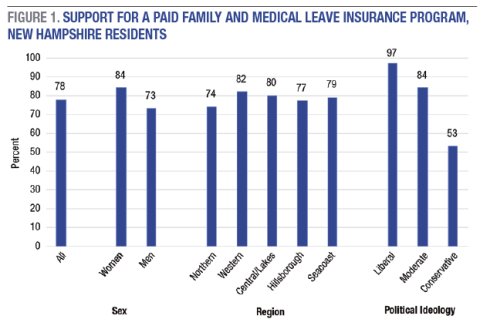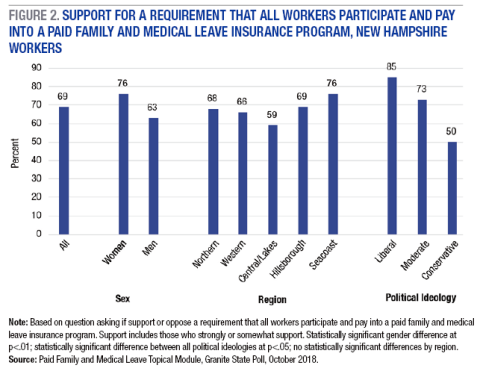download the brief
Key Findings

In October 2018, the last period for which we conducted public opinion research, support for a paid family and medical leave program was high. Seventy-eight percent of New Hampshire residents stated support for a program that would provide a portion of wages to workers taking leave for personal or family medical reasons.1 This was statistically unchanged from earlier research conducted in 2016. Women registered higher levels of support for paid family and medical leave insurance than men, and those with a liberal or moderate political ideology reported higher support than those with a conservative ideology (Figure 1). Levels of support did not vary significantly between regions in the state.
Related to the specific question of whether a program should require participation or be voluntary: more than two-thirds, 69 percent, of New Hampshire workers supported the inclusion of a requirement that all workers participate and pay into a paid family and medical leave insurance program. Patterns in support for this all-worker approach follow those seen in overall support for a program, namely men and those with a conservative ideology registered lower support than their counterparts, and differences by region were not statistically significant (Figure 2).
When those who opposed an all-worker program were asked if their opinion would change if they were told that allowing workers to opt out of the program would result in those who opted in paying substantially more for coverage, 34 percent changed their mind and no longer opposed the requirement of participation. This raised support for an all-worker program to 78 percent of workers. Simulation models estimate premium costs 30 to 60 percent higher under a voluntary opt-in program than under an all-worker program, depending on the participation level.2


1. These include caring for a newborn or newly adopted child or a seriously ill family member, or tending to one’s own serious illness.
2. Jeff Hayes and Meika Berlan, “Costs and Benefits of Family and Medical Leave for New Hampshire Workers” (IWPR, Washington, DC: 2016).
Kristin Smith is a family demographer at the Carsey School of Public Policy and research associate professor of sociology at the University of New Hampshire (kristin.smith@unh.edu).